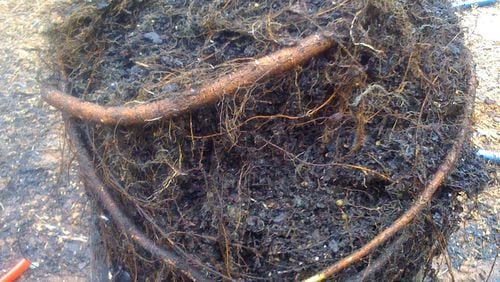Q: One of our young Japanese maple trees did not survive the heat and dry weather last year. Can I replace it now or would it be best to wait until this fall? Debra Payne, Bartow County
A: If you're attentive to watering in dry weather, it would be fine now to plant a Japanese maple grown in a container. Be sure to pull the tree out and examine the major roots before planting. You might need to wash off some soil to see them clearly. Determine if there are any circling roots growing in the soil. If so, untangle them and straighten them to grow outward from the trunk. The topmost major root should be just beneath the soil surface when the tree is in place.
Q: I saw strawberry plants for sale that had "GMO free" on the label. What fruit plants are GMO? Name Withheld, email
A: As far as I know, only Hawaiian papaya might be fruit that's a GMO (genetically modified organism), but note that not all papayas are GMOs. In my opinion, the label is simply a marketing strategy. None of the common fruiting plants (apple, pear, fig, peach, blueberry, etc) are a GMO. Home garden vegetables are the same: no GMOs. That said, you probably consume more GMO food than you realize. There's a good chance that products that contain corn, soybeans, white sugar or canola were manufactured from GMO plants. I'm not saying GMO food is safe or unsafe, just that many GMO items, including the cotton clothing you're wearing, are ubiquitous and unrecognized.
Q: I plant pickling cucumbers each year but lots of them are short and dumpy and curling up on the end. What causes this? Derrill Snelgrove, Lilburn
A: Easy — the pickles didn't get pollinated. On this year's vines, notice that there are two kinds of flowers. Some flowers have a straight green stem underneath that connects to the main vine. Other flowers have a small cucumber beneath. The former are male flowers; the ones showing a tiny cucumber are female flowers. The goal is to get an insect to carry pollen from the male flower to its female counterpart. You can increase the chances for full pollination by planting flowers among your vines. I recommend Mexican heather, zinnia, salvia, and verbena. You'll enjoy the flowers' color in your garden and pollinators will be drawn to their nectar. I have details on cucumber, squash and melon pollination, plus a longer list of pollinator plants at bit.ly/GApollinate.
Q: I heard that pollen counts are getting high. Is this good for bees? Mark Oliver, email
A: Not really. Most of the pollen drifting around is from trees, which are typically wind-pollinated. They don't need insects to carry pollen from flower to flower. Further, their flowers contain no nectar to attract pollinators.
Q: I mulch my flower garden with colored pine bark nuggets. Is it okay to till in these nuggets to amend the soil? Joel Norris, email
A: To my knowledge there is no harm in the dye used on these chips. I would simply till them into the ground without worry.






